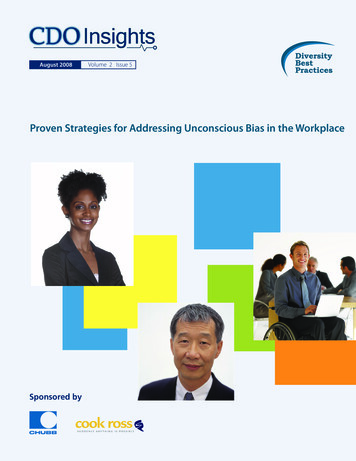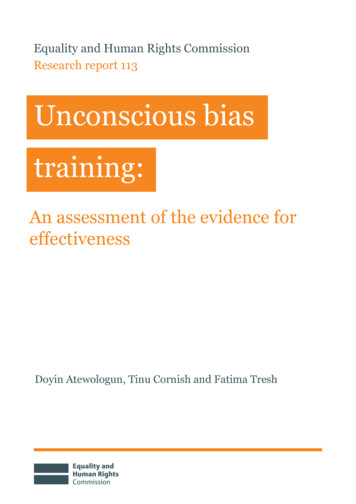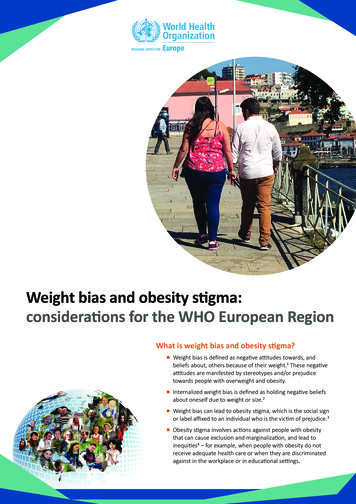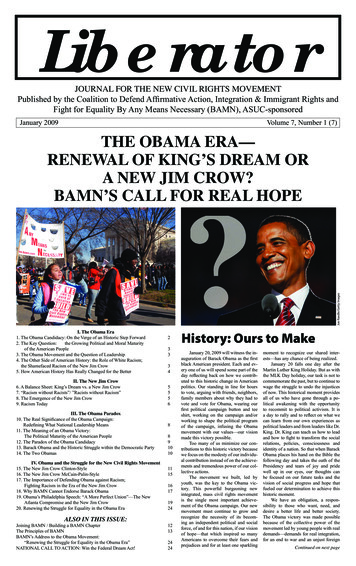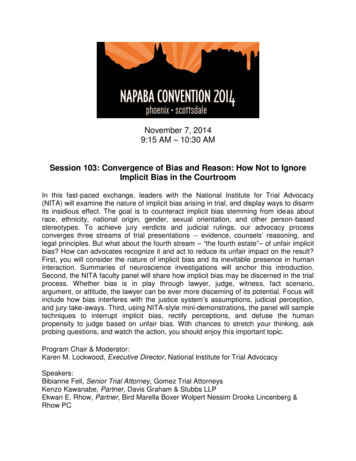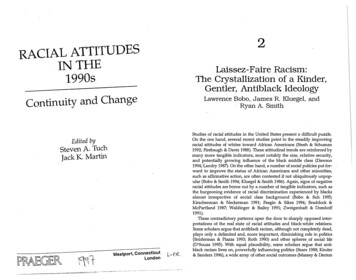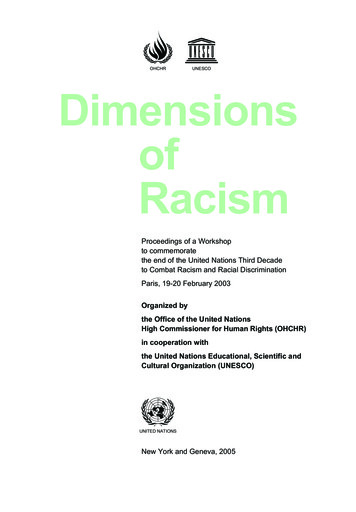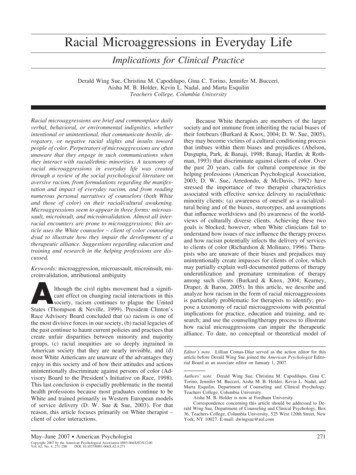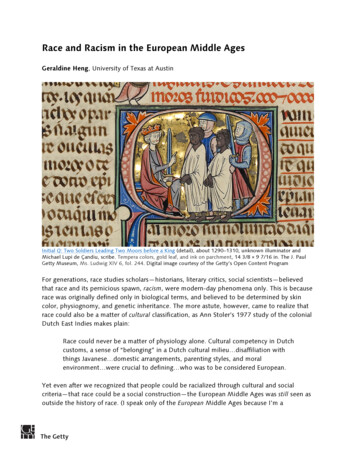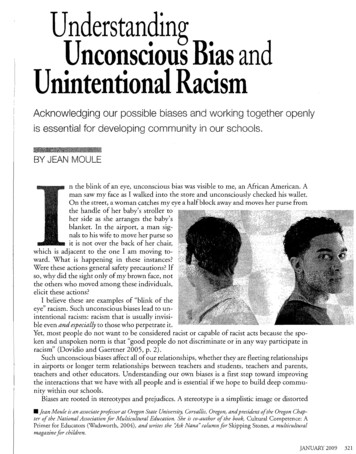
Transcription
UnderstandingUnconscious Bias andUnintentional RacismAcknowledging our possible biases and working together openlyis essential for developing community in our schools.BY JEAN MOUlEn the blink of an eye, unconscious bias was visible to me, an Mrican American. Aman saw my face as I walked into the store and unconsciously checked his wallet.On the street, a woman catches my eye a half block away and moves her purse fromthe handle of her baby's stroller toher side as she arranges the baby'sblanket. In the airport, a man sig nals to his wife to move her purse soit is not over the back of her chair,which is adjacent to the one I am moving to ward. What is happening in these instances?Were these actions general safety precautions? Ifso, why did the sight only of my brown face, notthe others who moved among these individuals,elicit these actions?I believe these are examples of "blink of theeye" racism. Such unconscious biases lead to un intentional racism: racism that is usually invisi ble even and especially to those who perpetrate it.Yet, most people do not want to be considered racist or capable of racist acts because the spo ken and unspoken norm is that "good people do not discriminate or in any way participate inracism" (Dovidio and Gaertner 2005, p. 2).Such unconscious biases affect all of our relationships, whether they are fleeting relationshipsin airports or longer term relationships between teachers and students, teachers and parents,teachers and other educators. Understanding our own biases is a first step toward improvingthe interactions that we have with all people and is essential if we hope to build deep commu nity within our schools.Biases are rooted in stereotypes and prejudices. A stereotype is a simplistic image or distorted Jean Moule is an associate professor at Oregon State University, Corvallis, Oregon, andpresident o/the Oregon Chap ter 0/ the National Association fOr Multicultural Education. She is co-author 0/ the book, Cultural Competence: APrimer for Educators (Wadsworth, 2004), and writes the 'I1sk Nana" column fOr Skipping Stones, a multiculturalmagazinefOr children.JANUARY 2009321
truth about a person or group based on a prejudgmentof habits, traits, abilities, or expectations (Weinsteinand Mellen 1997). Ethnic and racial stereotypes arelearned as part of normal socialization and are consis tent among many populations and across time. An ex cellent illustration of this phenomenon is a recent ex change that repeated Clark's classic 1954 doll study. Ina video, completed by a 17-year-old film student anddisseminated through the media, a young black childclearly reflects society's prejudice: The child describesthe black doll as looking "bad" and the white doll as"nice" (Edney 2006). Children internalize our society'sbiases and prejudices, as have all of us; they are just alittle less able to hide it. I am reminded of the story ofa 4-year-old in an affluent suburb who remarked to hermother upon seeing a young Latina while in line at thegrocery store, "Look, mommy, a baby maid."And when we receive evidence that confronts ourdeeply held and usually unrecognized biases, the hu man brain usually finds ways to return to stereotypes.The human brain uses a mechanism called "re-fenc ing" when confronted with evidence contrary to thestereotype. Allport coined the term: "When a factcannot fit into a mental field, the exception is ac knowledged, but the field is hastily fenced in againand not allowed to remain dangerously open" (Allport1954, p. 23). This is illustrated by such statements as"some of my best friends are black." That statement,while used to deny bias, has within it the seeds of adefense of negative feelings toward blacks. The con text of the statement usually means that "my bestfriend" is an exception to stereotypes and, therefore,that other blacks would not be my friends. Thomp son (2003) refers to this as absolution through a con nected relationship (i.e., I am absolved from racismbecause my best friend is black). Dovidio and Gaert ner describe this inability to connect stated beliefs andunconscious bias as aversive racism, "the inherent con- .tradiction that exists when the denial of personal prej udice co-exists with underlying unconscious negativeUNCOVERING BIASESBecause people are more likely to act out ofunconscious or hidden bias, knowing that youhave a bias for or against a group may cause youto compensate and more carefully consider yourpossible repponses or actions. AcknoWledgingbiases often opens doors for learning arid allowspeople to consciously work for harmonyinclassrooms and communities (Polite and Saenger2003). How do we find a key to unlock this door tothe mind? The Implicit Association Test (IAT) hashelped millions of people - those who accept thegften startling results - reveal their unconsciousbiases to themselves (https://implicit.harvard.edu/implicit/).Anthony Greenwald and Mahzarin Banaji developedthe test in the mid-1990s because "it iswell knownthat people don't always 'speak their minds,' and itis suspected that people don't always 'know theirminds' " (Greenwald, McGhee, and Schwartz 1998).The IAT "presents a method that convincinglydemonstrates the divergences of our consciousthoughts and our unconscious biases," accordingto the Harvard web site on Project Implicit.The IAT may be taken on this site wW'N.tolerance.org/hidden bias/tutorials/04.html322PHI DELTA KAPPANStrangely enough, the first evidence of thisunconscious bias came from insects and flowers.Greenwald made a list of 25 insect names and 25flower names and found thatit was far easier toplace the flowers in groups with pleasant words andinsects in groups with unpleasantwords than thereverse. It was justdifficult to "hold a mentalassociation of insects with words such as 'dream,''candy,' and 'heaven,' and flowers with words suchas 'evil,' 'poison' and 'devil'" (Vedantam 2005, p.)).Greenwald then took the next step and usedstereotypically white-sounding names, such asAdam and Emily, and black-sounding names, suchas Jamal and Lakisha , and grouped them withpleasant and unpleasant words. According toVedantam, Greenwald himself was surprised: "Ihad as much trouble pairing African-Americannames with pleasant words as I did insect nameswith pleasant words" (Vedantam 2005, p. 3). Hiscollaborator, Banaji, was even more self-reflective," 'I was deeply embarrassed,' she recalls. 'I washumbled in a way that few experiences in my lifehave humbled me' " (p. 3).This unconscious pairing has direct real-worldconsequences. Unconscious bias allows peoplewho consciously said they wanted qualifiedminority employees to then unconsciously rate
feelings and beliefs" (2005, p. 2).In many situations, from either the dominant orthe oppressed, simple unconscious associations maydrastically change outcomes. An example is Steele andAaronson's (1995) work on stereotype threat, in whichthe performance of African-American students in atesting situation was cut in half by asking them toidentify their race at the start of the test. This simpleact unconsciously reminded students of the stereo types connected with their race. Moreover, whenasked at the end of the test, the students who wereprimed to remember their race were unable to iden tify the reminder as a factor in their poorer test score(Steele 1997).In ambiguous situations, people's minds may alsoreconstruct a situation in order to conform to theirstereotypes. An example is a study of people who har bor negative attitudes about African Americans: In aquickly seen image in which a white man with aweapon chases a black man, some people reverse theresumes with black-sounding names as lessqualified. With other factors held constant, whlte sounding names at the top of resumes triggered50% more callbacks than African-Americannames. Human resources managers were stunnedby the results. Explicit bias can occur not onlywithoutthe intent to discriminate, but despiteexplicit desires to recruit minorities (Bertrand andMullainathan 2004).In See No Bias,Vedantam (2005) shares thedisappointment and surprise that two recent testtaker experi t3nced when theyfoundthattheirresults on t1'Jelmplicit Association Test did notmesh vvithfheir perceived vl e softhe selves. Tovvf1lthe dismay qf it1'Jese indlVlduals,thetestresultswere alsolnconflictv,vit1'J .their life and career goals.Vedantam describes In detaJI.a woman ,anactivlst,takinga··recentversronof the test:Th vvom n brought upa test en her computer from aHarvard University web site. It was really very simple: All it8.skedher foOb was distihguish between a series ofblack and white faces. When she saw a blackface, shewas to hita key on the leftil,JVhen she saw a white face,sDe was to ita key on the right. Next, she was a9ked todistinguish between a series of positive and negativewordS. Words such as "glorioUs" and "wonderful"required. a left key, words sLlch as "nasty" and "awful"required a right key. The test remained simple when twocategories were combined: The activist hit the left key ifrace of the perpetrator of the violence in order tomake it conform with their preconceived notions(Diller and Moule 2005). Such unconscious biaseshave a role in determining the length of jail sentences(Vedantam 2005) and the fact that, regardless of ex plicit racial prejudices, police officers are more likelyto shoot an unarmed black target than an unarmedwhite target (Correll et al. 2002).Regarding violence, it is important to rememberthat we are programmed to quickly discern who is en emy and who is friend, for in the past - and certain 1y in many places in the world today - the ability toquickly identify friend or foe may be a matter of lifeor death (Begley 2004).While I started this piece with evidence of peoplewho responded to their gut reactions to my brownskin in surprising nonverbal ways, many of the samepeople would be quite gracious if given another sec ond or two. Recent research shows that while mostpeople have an instant activity in the "fight or flight"she saw either a white face or a positive word, and hit theright key ifshe saw either a black face ora negativeword.Then thegroupings were reversed. The woman's indexfingers hovered over her keyboard. The test now requiredher to group black faces with positive words, and whitefaces with negative words. She leaned forward intently.She made no mistakes, but it took her longer to correctlysort the wbrds and images.Her result appeared on the screen, and the actiVist be came very silent. The test found she ha ;J a bias for Whitesover blacks."ltsl1rprises me I have an preferences.a tall," shesqid."Byth work I do, by my .education, rTly.background. I'mprog e9sive, and.1 thinkl aveno bias. Being. a minoritymyself, Idon't feel I should orwould have biases." 'I'm surprised," the l,JVoman said.She.b.it her Jip."And dis appbinted ." (p. 2) uch reactions should not really·bea surpriseaccording to the writings .of manywhlteanti-raolstactivlsts,inc.luding Tim Wise, w1'Joacknowledgeresidual racism still inside them. Wise notes howuncorJscious bias relegates the role of whitenessorrace "to anonfactor in the minds of whites"(2005, p. 18). When the role of w1'JiteQess or racebecomes crear to a person, such as the activistdescribed above, surprise and disappointment arelikely results.JANUARY 2009323
amygdala part of their brains upon encountering anunexpected person or situation, that first reaction is of ten consciously overridden in a nanosecond by manypeople in order to overcome built-in biases and re spond as their better, undiscriminating selves. ThisI pick up subtle clues, either consciouslyor unconsciously, as to who is agood,open contact for me versus someone whomay have difficulty engaging with meeasi Iy based on race.ability to overcome embedded biases is particularlyimportant when we consider that, "although manywhite Americans consider themselves unbiased, whenunconscious stereotypes are measured, some 90% im plicitly link blacks with negative traits (evil, failure)"(Begley 2004, p. 1).Gladwell goes on to describe the possible repercus sions ofthese unconscious biases at a job interview. Th same factors may affect behaviors in parent-teacherconferences or affect student outcomes in classrooms.Another study describes matching whites withblacks for the completion of a task (Dovidio andGaertner 2005). Whites were first divided into twogroups: those who expressed egalitarian views andthose who expressed their biases openly. These indi viduals were then observed to see if their actions, suchas those described by Gladwell, showed unconsciousbiases. Each white person then engaged in a problem solving task with a black person. The time it took tocomplete the joint task was recorded (see Table 1).Two important points bear emphasis here. First,the Mrican-American individuals, either consciouslyor unconsciously, were aware of the behavior thatshowed bias. In this study, "blacks' impressions ofwhites were related mainly to whites' unconscious at titudes. the uncomfortable and discriminatory beTABLE 1.CHANGING ATTITUDESDo we have the ability to change our attitudes andbehaviors? Gladwell explains the two levels of con sciousness in a manner that gives us hope. He says thatin many situations, we are able to direct our behaviorusing our conscious attitudes - what we choose tobelieve or our stated values - rather than our "racialattitude on an unconscious level- the immediate, au tomatic associations that tumble out before we'veeven had time to think" (2005, p. 84). He continues,"We don't deliberately choose our unconscious atti tudes. we may not even be aware of them" (p. 85).Because our unconscious attitudes may be complete ly incompatible with our stated values, we must knowjust what those unconscious attitudes are, for they are,as Gladwell states, a powerful predictor of how wemay act in some spontaneous situations.Gladwell describes the type ofcircumstances whereblacks and whites will both engage and disengagearound climate and personal relation issues:If you have a strongly pro-white pattern of associations.there is evidence that that will affect the way you behave inthe presence of a black person. In all likelihood, youwon't be aware that you are behaving any differently thanyou would around a white person. But chances are you'll leanforward a little less, turn away slightly from him or her, closeyour body a bit, be a bit less expressive, maintain less eye con tact, stand a little farther away, smile a lot less, hesitate andstumble over your words a bit more, laugh at jokes a bit less.Does that matter? Of course it does. (pp. 85-86)324PHI DELTA KAPPANBiased and Unbiased White Individuals'Time to Complete Paired TaskWhite Memberof PairUnbiased in word and behaviorBiased in word and behaviorUnbiased by self-report,behavior shows biasTime toCompleteTask with aBlack Person4 minutes5 minutes6 minuteshavior associated with aversive racism is very obviousto blacks, even while whites either don't recognize itor consider it hidden" (Dovidio and Gaertner 2005,pp. 3-4). I know that as an African American, when Ienter a room of white people, I pick up subtle clues,either consciously or unconsciously, as to who is agood, open contact for me versus someone who mayhave difficulty engaging with me easily based on myrace.Second, white individuals who said they were un biased, yet showed nonverbal biased behavior, report ed their impressions of their behavior related to theirpublicly expressed attitudes and were likely to maintaintheir stated level of biases when questioned. There fore, they are likely to blame the victim, the black in dividual, for their slowness in completing the task(and incidentally, possibly reinforce their stereo types). Sleeter contends, "We cling to filters that
screen out what people of color try to tell us becausewe fear losing material and psychological advantagesthat we enjoy" (1994, p. 6).We are far better off to acknowledge ourpossible biases and to try to work togetheropen Iy with that knowledge.It is important to note that the well-intentioned arestill racist:Because aversive racists may not be aware of their uncon scious negative attitudes and only discriminate againstblacks when they can justifY their behavior on the basis ofsome factor other than race, they will commonly deny anyintentional wrongdoing when confronted with evidence oftheir biases. Indeed, they do not discriminate intentionally.(Dovidio and Gaertner 2005, p. 5)For example, if white individuals who are self-de ceived about their own biases were sitting in a posi tion to influence a promotion decision, they mightnot support the advancement of a "difficult" black in dividual and would select another factor as a reasonfor their action, rather than see or acknowledge theirown conflicted perceptions.This study on task completion strongly suggeststhat we are far better off to acknowledge our possiblebiases and to try to work together openly with thatknowledge. If we mask our true attitudes, sometimesinvisible to our own selves, we will continue to workslowly or unproductively. Consider the white individ uals whose conflict over their true or hidden selvesand their outward statements made a simple task bothtime-consuming and psychologically difficult forboth the black individuals and themselves (Dovidioand Gaertner 2005).Unintentional racism is not always determined bywhether an individual possesses prejudiced beliefs orattitudes, and it can take many different forms. Theseforms include the unconscious gestures mentionedbefore or "the dominant norms and standards."Because many people believe these norms and standards areculturally neutral and universally right, true, and good, theydo not understand how these norms and standards oppressothers. They are not even aware of this possibility - and,in this sense, such racism is unintentional. (Applebaum1997, p. 409)HARD WORK OF HONESTYUnpacking our levels of consciousness and intentrequires hard work. First, there needs to be unswerv ing, unnerving, scrupulous honesty. Individuals needto become less focused on feeling very tolerant andgood about themselves and more focused on examin ing their own biases. One must realize and accept thatthe foundation and continuation of a bias may have,at its root, personal and group gain.I recall sharing with my graduate and undergradu ate students that true equity will be reached when40% of all service people. meaning hotel house keepers, groundskeepers, etc., are white men. The lossfrom 80% of the managerial jobs in this country to40%, their proportion ofthe population, would be anactual loss in the number of jobs currently allotted to Do notbegiMcrying. (These are some of the r'i'\r'\d.lhflwhen they challenge a situation that feels 'Alrr" 111II If you hear about something third-hand, don't get angry. Remember that it is almost never completelysafe for a person of color to challenge a dominant perception.Source: Dovidio, Jack F., and Sam L. Gaertner. "Color Blind or Just Plain Blind." Nonprofit Quarterly (Winter2005): 5.JANUARY 2009325
them based on race and gender. That is, they wouldnot have the jobs they may perceive as expected andmodeled as their right in the workplace. Can we allembrace such a future? Delpit maintains, "Liberal ed ucators believe themselves to be operating with goodintentions, but these good intentions are only con-Individuals need to become less focusedon feeling very tolerant and good aboutthemselves and more focused onexamining their own biases.scious delusions about their unconscious true mo tives" (Delpit 1988, p. 285). I am not quite that cyn ical. I believe in change, slow as it may be.Finally, Teaching Tolerance, a group dedicated toreducing prejudice, improving intergroup relations,and supporting equitable school experiences for ournation's children, says, "We would like to believe thatwhen a person has a conscious commitment tochange, the very act of discovering one's hidden bias es can propel one to act to correct for it. It may notbe possible to avoid the automatic stereotype or prej udice, but it is certainly possible to consciously recti fy it" (200 1, p. 4). Otherwise, we are all at the mercyof a blink of the eye.KREFERENCESAllport, Gordon. The Nature of Prejudice. Cambridge,Mass.: Addison-Wesley, 1954.Applebaum, Barbara. "Good, Liberal Intentions Are NotEnough: Racism, Intentions, and Moral Responsibility."Journal of Moral Education 26 (December 1997): 409-421.Begley, Sharon, "Racism Studies Find Rational Part ofBrain Can Override Prejudice." Wall Street Journal,November 19, 2004, p. B1.Bertrand, Marianne, and Sendhil Mullainathan. "AreEmily and Greg More Employable Than Lakisha andJamal?" American Economic Review 94 (2004): 991 1013.Correll, Joshua, Bernadette Park, Charles. M. Judd, andBernd Wittenbrink. "The Police Officer's Dilemma: UsingEthnicity to Disambiguate Potentially ThreateningIndividuals." Journal of Personality and SocialPsychology 83 (December 2002): 1314-1329.Delpit, Lisa. "The Silenced Dialogue: Power and326PHI DELTA KAPPANPedagogy in Educating Other People's Children."Harvard Educational Review 58 (August 1988): 280-298,Diller, Jerry V, and Jean Moule. Cultural Competence: APrimer for Educators. Belmont, Calif.: Wadsworth, 2004.Dovidio, Jack F" and Sam L. Gaertner, "Color Blind orJust Plain Blind," Nonprofit Quarterly (Winter 2005),Edney, Hazel Trice. "New 'Doll Test' Produces UglyResults." Portland Medium, August 18, 2006, pp. 1, 7.Gladwell, Malcolm, Blink: The Power of Thinking WithoutThinking. New York: Little, Brown, 2005.Greenwald, Anthony, Debbie E, McGhee, and Jordan L.K. Schwartz. "Measuring Individual Differences in ImplicitCognition: The Implicit Association Test." Journal ofPersonality and Social Psychology 74 (June 1998):1464-1480.Harvard University. "Project Implicit" 2007,https://implicit.harvard.edu/implicit.Polite, Lillian, and Elizabeth B. Saenger. "A PerniciousSilence: Confronting Race in the ElementaryClassroom." Phi Delta Kappan 85 (December 2003):274-278.Sleeter, Christine E. "White Racism." MulticulturalEducation 1 (Summer 1994): 1, 5-8,Steele, Claude, "A Threat in the Air: How StereotypesShape Intellectual Identity and Performance." AmericanPsychologist 52 (June 1997): 613-629,Steele, Claude M" and Joshua Aaronson. "StereotypeThreat and Intellectual Test Performance of AfricanAmericans." Journal of Personality and SocialPsychology 69 (November 1995): 797-811,Teaching Tolerance. "Hidden Bias: A Primer." 2001.www.tolerance.org/hidden bias/tutorials/04.html.Thompson, Audrey. "Tiffany, Friend of People of Color:White Investments in Antiracism," International Journalof Qualitative Studies in Education 16 (January 2003):7-29.Vedantam, Shankar, "See No Bias," Washington Post,January 23, 2005, p. 3, www.vedantam.com/bias01-2005.html,Weinstein, Gerald, and Donna Mellen,. "Anti-SemitismCurriculum Design." In Teaching for Diversity and SocialJustice, ed. Maurine Adams, Lee Anne Bell, and PatGriffin, New York: Routledge, 1997.Wise, Tim. White Like Me: Reflections on Race from aPrivileged Son, Brooklyn, I\J.Y.: Soft Skull, 2005,
n the blink of an eye, unconscious bias was visible to me, an Mrican American. A man saw my face as I walked into the store and unconsciously checked his wallet. On the street, a woman catches my eye a halfblock away and moves her purse from the handle of her baby's stroller to her side as s

